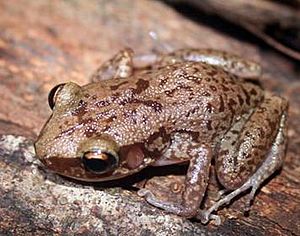Mona coqui facts for kids
Quick facts for kids Mona coqui |
|
|---|---|
 |
|
| Conservation status | |
| Scientific classification |
The Mona coqui is a small frog that lives only on Mona, Puerto Rico. This means it is endemic to that island, found nowhere else in the world! It is also known as the coqui de la Mona or coqui de Mona. Its scientific name is Eleutherodactylus monensis.
These special frogs live in habitats like dry forests and dry shrublands. These are places with warm weather and not too much rain. They are part of the Eleutherodactylidae family of frogs.
Contents
What is a Mona Coqui?
The Mona coqui is a type of coqui frog. Coqui frogs are famous in Puerto Rico for their loud calls. The word "coqui" sounds like the call they make! These frogs are usually small. They have special pads on their toes that help them climb.
Where Does it Live?
The Mona coqui lives only on Mona Island. This island is located between Puerto Rico and the Dominican Republic. It is a dry, limestone island. The frogs hide in damp places during the day. They come out at night to find food.
What Does it Eat?
Mona coquis are carnivores, which means they eat other small animals. They mostly eat tiny insects and other invertebrates. They use their long, sticky tongues to catch their prey.
How Do They Reproduce?
Unlike many frogs, coquis do not lay their eggs in water. Instead, the female Mona coqui lays her eggs on land, often in damp places under leaves or rocks. The male frog usually guards the eggs until they hatch. Tiny froglets hatch directly from the eggs. They do not go through a tadpole stage like many other frogs. This is a unique feature of coqui frogs!
Why is the Mona Coqui Important?
The Mona coqui is an important part of the ecosystem on Mona Island. It helps control insect populations. It also serves as food for other animals. Because it lives only on Mona Island, it is very special. Losing this frog would mean losing a unique species forever.
What Threats Does it Face?
The Mona coqui is listed as "Vulnerable" by the IUCN. This means it faces a high risk of becoming endangered. Its main threats include habitat loss and changes to its environment. Things like climate change or new species arriving on the island could also harm them. Protecting their dry forest and shrubland homes is very important for their survival.
See also
- List of amphibians and reptiles of Puerto Rico
- Fauna of Puerto Rico
- List of endemic fauna of Puerto Rico
 In Spanish: Coquí de Mona para niños
In Spanish: Coquí de Mona para niños


